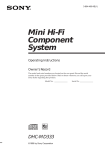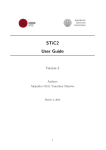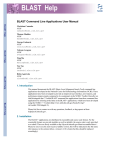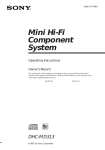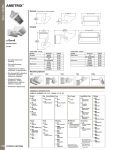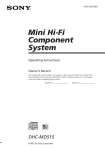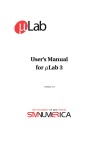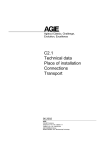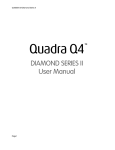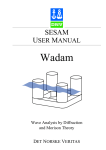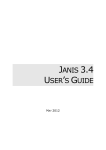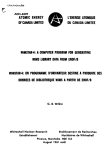Download User's Guide to fete: From ENDF/B-VI To ENDL
Transcript
UCRL-SM-206606
User’s Guide to fete: From ENDF/B-VI To ENDL
David Brown and Gerald Hedstrom
Lawrence Livermore National Laboratory, Livermore, CA 94550 USA
Tony Hill
Los Alamos National Laboratory, Los Alamos, NM USA
(Dated: September 17, 2004)
This guide describes how to run the fete ENDF/B-VI to ENDL translation code and outlines
some of the general features of the translation process. In particular, this guide details how to install
the code and supporting scripts, how to prepare an ENDF/B-VI formatted database for translation,
how to translate the database, and how to check the translated database. This guide also explains
how fete treats each ENDF/B-VI reaction and data type.
Acknowledgments
Contents
I. Introduction
II. Steps in Translating
A. Installing the translation code & scripts
1. Getting the translation code
2. Building the codes
3. The bdfls file
4. Setting up the environment
B. Getting and preparing the database
1. Getting a database from the web
2. Getting a database from the CVS
3. Database preparation
4. The mini-db utility
C. Translating the database & computing energy
deposition
1. translate vs. translate all
2. Invoking fete from the command line
D. Checking the translation
1. The build errlist.py utility
2. The view all.py utility
3. The za comp and yo comp utilities
III. Translation Details
A. General information on the reaction data in
ENDF/B-VI.
1. MF=1 (Documentation)
2. MF=2 (Resonance Data)
3. MF=3 (Cross Section Data)
B. Data on massive particles, ordered by MF
number.
1. MF=4 (Outgoing Angular Distributions)
2. MF=5 (Outgoing Energy Distributions)
3. MF=6 (Outgoing Energy–Angle
Distributions)
C. Gamma data.
1. MF=12 (Multiplicity) and MF=13 (Cross
Section Data)
2. MF=14 (Angular Distributions)
3. MF=15 (Energy Distributions)
D. Delayed neutrons
IV. Conclusions
1
2
2
2
2
2
2
3
3
5
5
5
5
6
6
6
6
6
6
6
7
7
7
7
8
8
8
8
9
9
10
10
10
10
11
A. Preprocessing ENDF/B-VI Data
1. Split the ENDF data
2. Official IAEA Preprocessing codes
3. Preprocessing code – linear
4. Preprocessing code – recent
5. Preprocessing code – sigma1
11
11
11
11
12
12
B. Double differential data in ENDF/B-VI
1. The domain in the laboratory frame
2. Center-of-mass probability density
3. The Jacobian
12
13
13
13
C. LLNL Disclaimer
14
References
I.
14
INTRODUCTION
This guide is a description of the LLNL Computational
Nuclear Physics (CNP) Groups’s “From ENDF/B-VI To
ENDL” (a.k.a. fete) code. fete translates nuclear reaction data from the ENDF/B-VI to Livermore’s internal ENDL [1] format. ENDF/B-VI is both an evaluated
nuclear data library [2] and an international standard
data format [3] for evaluated nuclear data. Because of
the significant difference in both format and content, the
translation process is a complicated multi-step process.
All of ENDL data is presented in point-wise linearly
interpolated tables while ENDF/B-VI data is presented
in a variety of manners, depending on the reaction and
quantity in question. The two formats also differ in the
arrangement of the data in the databases. Data in the
ENDF/B-VI format are divided into materials (abbreviated MAT), which are further divided into “Material
Files” (abbreviated MF). An MF is one type of reaction data (e.g. MF=3 is tabular cross section data).
These MF’s are subdivided into “Material Tapes” (abbreviated MT) which contain the data for individual reactions. Thus MT=16 MF=3 contains (n,2n) reaction
cross section data while MT=18 MF=3 contains the total
(n,f) reaction cross section. By contrast, ENDL requires
2
that reactions and nuclei be sorted into nesting directories first according to projectile (e.g. yi01 means incident
neutron), then nuclide (e.g. za001002 means Z=1 and
A=2 so we have deuterium), then reaction. The data
for each reaction has several numbers associated with it,
namely yo to denote the outgoing particles, C to denote
reaction type and I to denote reaction property. The
ENDL C and I numbers are analogous to the ENDF/BVI MF and MT numbers, respectively. However, we caution that the mapping from (MF,MT) to (C,I) is not this
straightforward as we see in Tables I and II.
In this note, we will first cover the installation and use
of the translation codes and supporting scripts. Second,
we will detail the translation process and highlight issues
of which a user should be aware. Finally, we will discuss
some of the outstanding issues in the translation: the extensions that ENDL will need in order to support the rest
of the ENDF/B-VI format and some of the bugs found
both in the format specifications and in the databases.
This note also contains two appendices covering some of
the issues in greater detail. The first appendix details the
preparation of the databases for translation and the various preprocessing codes. This includes a discussion of
the Doppler broadening performed at this step. The second appendix details some of the mathematical issues encountered in translating ENDF/B-VI double differential
data. This note does not go into the detailed workings of
the code. This is covered in the fete Code Reference [4]
documentation that accompanies the source code distribution.
II.
STEPS IN TRANSLATING
The entire ENDF/B-VI to ENDL translation process
is summarized:
A.
Installing the translation code & scripts
1.
Getting the translation code
fete is available either as a tarball on Livermore’s CNP Group web page [5] or internally on
the CNP Group’s CVS. The CVS is located at
ndg.llnl.gov:/cvsroot/ and this project’s name is
fete. The tarball unpacks to a directory called fete/.
2.
Building the codes
To build the package, enter the main project directory
(fete/) and type “make.” If compilation went well, an
executable file called fete will be left in the src/ directory. We recommend moving this executable file as well
as the contents of the scripts/ directory to some place
in your environment’s path. Our preference is to put all
of the executable files in $NDSPATH/bin/ directory. Here
$NDSPATH is an environment variable that points to a directory containing this project as well as the other code
projects needed for nuclear data processing.
3.
The bdfls file
The bdfls file contains a variety of data required
by several of the codes maintained by the CNP group.
In particular, the bdfls file contains group boundaries,
fluxes, nuclear masses, half-lives, various physical and
conversion constants, and atomic excitation levels. fete,
endep [6] and fudge [7] all require masses.
A copy of the bdfls file is included in the src/ directory of the fete package. You will need to set the
$BDFLSPATH environment variable to point to the bdfls
file. If you do not set this variable, fete will attempt to
load the bdfls file from the ‘.’ directory. Furthermore,
most of the supporting scripts will fail without this environment variable.
1. Install the translation code and scripts
4.
Setting up the environment
2. Acquire and prepare a database
3. Translate the database
4. Compute energy depositions
5. Check results
In the following subsections, we will explore each step.
We assume some familiarity with unix or related systems.
This code system is known to work on Redhat Linux
versions 8.0 and higher, MacOS X and higher (both using
gcc3.3) and on Solaris (using gcc2.95.3).
You will need several supporting codes in order to complete the translation:
1. prepro2000 – if preprocessing a database yourself
2. endfsplit – if preprocessing the ENDF/B-VI
database yourself
3. endep – to compute energy depositions
4. fudge – for checking the translation results
5. PERL, Python, csh, a c++ compiler, make
3
MF
1
2
3
4
5
6
7
8
9
10
12
13
14
15
23
27
30
31
32
33
34
35
39
40
a MT=451
Description
I
General information
Resonance parameter data
Reaction cross sections
Angular distributions for massive emitted particles
Energy distributions for massive emitted particles
Energy-angle distributions for emitted particles (γ’s or massive particles)
Thermal neutron scattering law data
Radioactivity and fission-product yield data
Multiplicities for radioactive nuclide production
Cross sections for radioactive nuclide production
Multiplicities for photon production
Cross sections for photon production
Angular distributions for photon production
Energy distributions for photon production
Photo-atomic interaction cross sections
Atomic form factors or scattering functions for photo-atomic interactions
Data Covariances obtained from parameter covariances and sensitivities
Data covariances for nubar
Data covariances for resonance parameters
Data covariances for reaction cross sections
Data covariances for angular distributions
Data covariances for energy distributions
Data covariances for radionuclide production yields
Data covariances for radionuclide production cross sections
n/aa
0b
0
1
4
3 or 4
n/ac
n/ad
n/ad
n/ad
9
0
4e
4
0
941
n/a
n/a
n/a
n/a
n/a
n/a
n/a
n/a
delayed neutron data is handled separately.
Red Cullen’s recent code.
b Translated into pointwise data using
c Not implemented in ENDL yet.
d Use ACTL for this data
e Only if not isotropic; if
type.
isotropic, this file is ignored since the
ENDL default is isotropic.
TABLE I: ENDFB-VI MF numbers and their rough ENDL equivalent.
Information on where and how to obtain these codes can
be found on the Computational Nuclear Physics Group’s
web page [5]. Getting these codes installed and working
is your own responsibility, however we provide details on
the splitting and preprocessing in Appendix A.
The various control scripts require that you set several environment variables ($BDFLSPATH, $ENDLPATH,
$FUDGEPATH), add the path to the fudge source to your
$PYTHONPATH and add the path to all of the executables
produced above to your $PATH. If you are using csh, you
may accomplish all of this by adding the following lines
(appropriately modified, of course) to your .cshrc file:
#
# Nuclear Data Processing System setup
#
setenv NDSPATH /home/joeuser/NDS
setenv BDFLSPATH $NDSPATH/bdfls
setenv ENDLPATH $NDSPATH/databases
setenv FUDGEPATH $NDSPATH/fudge
setenv PYTHONPATH "$FUDGEPATH/Src:$PYTHONPATH"
set path = ( $NDSPATH/bin $path )
B.
Getting and preparing the database
1.
Getting a database from the web
There are several modern databases that use the
ENDF/B-VI format: ENDF/B-VI, JENDL-3.3, JEFF3.0, BROND-2.2, and CENDL-2.1. ENDF/B-VI [2],
JENDL-3.3 [8], and JEFF-3.0 [9] are the most up to date
and are the main targets of our translation effort. All
three of these databases are available on the web, both
in raw and point-wise (i.e. preprocessed) form. Since the
preprocessing stage can take quite a bit of time (several
hours to a day or more, depending on your hardware), we
recommend downloading the preprocessed data. ENDL
requires that the data be Doppler broadened to 300 de-
4
MT Description
C
MT Description
C
1 (n,total)
1
115 (z,pd)
19
2 (z,elastic)
10
116 (z,pt)
39
3 (z,non-elastic)
55a
151 (n,resonance)
n/a
4 (z,n)
11b
201 (z,Xn)
56i
5 (z,anything)
n/a
c
202 (z,Xγ)
55i
10 (z,continuum)
n/ac
203 (z,Xp)
50i
11 (n,2nd)
32
204 (z,Xd)
51i
16 (z,2n)
12
205 (z,Xt)
52i
17 (z,3n)
13
206 (z,X3 He)
53i
207 (z,Xα)
54i
18 (z,f)
15
19 (n,f) – 1st chance fission.
n/ad
208-218 Various meson and antiparticle production σ’s n/a
20 (n,nf) – 2nd chance fission.
n/ad
251-253 Various elastic neutrons scattering parameters. n/a
21 (n,2nf) – 3rd chance fission.
n/ad
301 Energy release for total and partial σ’s.
n/a
22 (z,nα)
26
451 Heading or title information (MF=1 only).
n/a j
23 (z,n3α)
n/a
452 (z,f) ν
¯ total (prompt plus delayed) fission.
15 k
24 (z,2nα)
33
454 (z,f) Independent fission product yields.
15 k
25 (z,3nα)
16e
455 (z,f) ν
¯ for delayed fission.
15k
27 (n,abs)
n/ac
456 (z,f) ν
¯ for prompt fission.
15k
28 (z,np)
20,21f
457 (z,f) Radioactive decay data.
n/a
29 (z,n2α)
27
458 (z,f) Energy release in fission for incident n’s.
15 k
30 (z,2n2α)
n/a
459 (z,f) Cumulative fission product yields.
15 k
32 (z,nd)
22
500 Total charged particle stopping power.
n/a
33 (z,nt)
24
501 Total photon interaction σ.
70
34 (z,n3 He)
25
502 Photon coherent scattering.
71
35 (z,nd2α)
n/a
504 Photon incoherent scattering.
72
36 (z,nt2α)
n/a
505 Imaginary scattering factor.
n/a
37 (z,4n)
14
506 Real scattering factor.
n/a
38 (n,3nf) – 4th chance fission.
n/ad
515 Pair production, electron field.
n/a
41 (z,2np)
29
516 Pair production.
74
42 (z,3np)
16
517 Pair production, nuclear field.
n/a
44 (n,n2p)
17
522 Photoelectric absorption.
73
45 (n,npα)
34
50 (z,n[0]) – excitation of g.s.
11b,g
600 (z,p[0])
11b,g
601-648 (z,p[n])
40i
11b,g
649 (z,p[c])
40i
51-90 (z,n[n]) – excitation of n th excited state
91 (z,n[c]) – excitation to continuum
101 (n,disappearance)
n/ac
102 (z,γ)
46
534-572 Various subshell photoelectric σ’s.
n/a
40i
650 (z,d[0])
41i
651-698 (z,d[n])
41i
103 (z,p)
40
699 (z,d[c])
41i
104 (z,d)
41
700 (z,t[0])
42i
105 (z,t)
42
701-748 (z,t[n])
42i
106 (z,3 He)
44
749 (z,t[c])
42i
3
107 (z,α)
45
750 (z, He[0])
44i
108 (z,2α)
37
751-798 (z,3 He[n])
44i
109 (z,3α)
n/a
799 (z,3 He[c])
44i
111 (z,2p)
18
800 (z,α[0])
45i
112 (z,pα)
48
801-848 (z,α[n])
45i
113 (z,t2α)
42h
849 (z,α[c])
45i
114 (z,d2α)
n/a
851 Lumped reaction covariances.
n/a
a
If MF=12–15, then the outgoing γ’s are lumped in the C=55 file, otherwise the data is discarded since it should be
stored with individual reactions. The non-γ data is discarded since it is purely derived data.
If the sum inelastic option is set then use the MT=4 data, otherwise use the MT=51–91 data (lumping all γ data into
the C=55 file).
c
Purely a derived file, so it is not needed.
d
Only total fission data is stored in ENDL.
e
Below Einc = 20 MeV, only 7 Li has this reaction and 7 Li(n, 3np)α ≡7 Li(n, 3nα)p
f
ENDF/B-VI does not distinguish whether the proton or neutron is emitted first.
g
Level excitation functions stored in S=1 type files in ENDL.
h
Below Einc = 20 MeV, only 10 B has this reaction and 10 B+n → t+8 Be∗ → t + 2α
i
A slot exists in ENDL but this data is not translated.
j
ENDL does not yet have a slot for documentation.
k
Delayed fission information is stored in S=7 type files in ENDL.
b
TABLE II: ENDFB-VI MT numbers and their rough ENDL equivalent.
5
Database Name
CVS Project Name
Preprocessed
version in CVS?
ENDF/B-V
ENDF/B-VI
JEFF-3.0
JENDL-3.3
ENDF tapes/ENDF.B-V
ENDF tapes/ENDF.B-VI
JEFF-3.0
JENDL-3.3
N
N
Y
Y
my_db/yi01/za001001/endf.orig
"
/endf.prepro
/za001002/endf.orig
"
/endf.prepro
.
.
.
TABLE III: Databases in ndg.llnl.gov:/cvsroot/.
grees Kelvin, so care must be take to download the correct database.
2.
Getting a database from the CVS
Locally, we store preprocessed and unprocessed data
in our CVS repository. At the time of this writing, the
repository is located at: ndg.llnl.gov:/cvsroot/. Table III lists the databases and whether a preprocessed
version of the data is checked into our CVS.
3.
Database preparation
The ENDF/B-VI format specification makes no requirement as to how the data is arranged in the library,
so each nuclear data library is shipped in a different form.
In the case of the ENDF/B-VI database, all of the data
is lumped into “tapes,” hence the need for “splitting” the
database with the endfsplit code discussed in Appendix
A 1) and then preprocessing. JEFF-3.0 and JENDL-3.3
require unpacking and directory renaming. In the end,
we want the data in something like the ENDL standard
directory layout [1]:
my_db/yi01/za001001/endf.orig
/za001002/endf.orig
.
.
.
Here, the endf.orig file is the raw, unprocessed evaluation for one nuclide.
Once this is done, we must preprocess each orig file to
produce a prepro file. The prepro file differs from the
original file in that:
• All resonances are expanded into a linear-linear interpolable form
• All cross sections are heated to 300 K
This is mainly an automated process using the
prepro2000.csh script which controls Red Cullen’s
linear, recent and sigma1 codes [10]. This step is detailed in Appendix A 2. After this step, the database will
appear as:
4.
The mini-db utility
The mini-db utility is a simple script that copies out
a subset of targets from one database to another. This
is extremely useful for troubleshooting problem nuclides.
The utility is invoked with:
mini-db <isotope file> <output db> \
[master copy]
Here [master copy] is an optional argument and defaults to $NDSPATH/databases/ENDFB6 prepro/. The
required argument <isotope file> is a plain text file
containing a list of za numbers. The other argument
<output db> is the uppermost directory of the new,
miniature, database you are creating. A subdirectory
of <output db> called yi01/ containing the za files will
be created by the script.
C.
Translating the database & computing energy
deposition
Translation is very simple: go to the yi01/ directory, containing all of the za subdirectories, and execute
translate all. Provided everything is working, you will
have a fully translated database in those za directories,
complete with energy depositions. Your database directory should look something like this:
my_db/yi01/za001001/endf.orig
"
/endf.prepro
"
/endep_csh.log
"
/endep.log
"
/translate_csh.log
"
/translation.log
"
/yo00c01i000s000
"
/yo00c10i000s000
.
.
.
/za001002/endf.orig
"
/endf.prepro
.
.
.
The next few subsections explain the translate and
translate all scripts and how to invoke the fete code
directly. The translation may be “tweaked” using the
fete options.inp file and this mentioned below and is
discussed in more detail in Section III.
6
1.
translate vs. translate all
The translate all loops through a set of nuclei and
translates them all using translate. It may be invoked
using
translate_all [directory]
where [directory] is an optional argument that specifies the directory containing the za subdirectories. If this
argument is missing, the script defaults to processing the
current directory.
By contrast, translate script automates the translation of a single nuclide and is invoked via
translate <za number>
This script first invokes fete to translate the nuclide’s
data into ENDL format then it sets up and invokes the
endep.csh script. The endep.csh is the piece of code
that actually calls endep to compute energy depositions.
2.
Invoking fete from the command line
Although we usually invoke fete through either the
translate or translate all scripts, you may wish
to invoke fete directly on the command line via:
fete [-f options_file] [options]
fete expects that you invoke it in a za subdirectory and that an endf.prepro file exists in this directory. There are various options that control how the
translation proceeds and they can be overridden in the
fete options.inp file. These options are described in
Section III and listed in Table IV.
The -f option allows you to override the name
of the fete options.inp file. The options in the
fete options.inp file may also be overridden on the
command line by prepending a “-” to the option, e.g.
fete -tol_1d 0.001 -mf5_tol 0.000025
be installed to function and it is invoked with
build_errlist.py <database>
where <database> is the name of the directory containing the database to be checked. This script combs the
log files produced during the translation for errors in the
translation stage and the energy deposition stage. This
script also runs the fudge script check.py to check for
proper ENDL formatting. When finished, an HTMLformatted report will be generated in the <database>
directory, in the same level as the yi01/ directory.
To browse this report, point your web browser to the
translation summary.html file.
The translation summary.html file contains two sections. The first is a hyper-linked table of nuclides and
problems encountered during their processing. This table is linked to a page for each nucleus containing copies
of the log-files containing details of the problem. The
second section is a bulleted list of errors encountered in
the translation stage, each with a list of the nuclei that
encountered that error.
2.
view all.py is a tool that uses fudge to plot every
dataset in an ENDL formatted database. To use it, type
view_all.py <za> [database]
where <za> is the za number of interest and [database]
is an optional argument for the database containing <za>.
If this argument is skipped, view all.py will attempt to
look for <za> in the current directory.
3.
D.
Checking the translation
We provide some tools for checking and examining the
translation. The first, build errlist.py, builds a webpage summary of the translation errors. The second,
view all.py, allows you to plot all of the quantities in
the newly created ENDL formatted database. The last
two utilities, za comp and yo comp, are useful for comparing the contents of ENDL databases and individual
za directories.
1.
The build errlist.py utility
The Python script build errlist.py is a tool to build
an HTML-formatted report of all errors encountered in
translating a database. It requires the fudge package [7]
The view all.py utility
The za comp and yo comp utilities
These two utilities allow you to compare the contents
of two databases or two individual za/ subdirectories. To
compare two databases, do:
za_comp <db1> <db2>
To compare the contents of two za/ subdirectories, do:
yo_comp <za1> <za2>
III.
TRANSLATION DETAILS
In this section, we discuss what is involved in the actual translation. We start with the treatment of reaction cross sections. Then we discuss angle, energy, and
joint energy-angle distributions for massive particles (not
gammas). Following this, we discuss gamma data and we
conclude with a section on delayed fission neutrons. You
are encouraged to consult Tables I and II while reading
this section.
7
Key
Value
Description
Interpolation Options
tol 1d
0.005
Relative accuracy of 1-d list interpolation
cut off 1d
0.001
Suspend tol 1d below this absolute value (arb. units) a
tol 2d
0.015
Relative accuracy of 2-d list interpolation
cut off 2d
0.003
Suspend tol 2d below this absolute value (arb. units) a
dE tol
0.01
Maximum incident energy difference for 2-d lists (MeV)
log log tol
0.005
Relative error in converting log-log to lin-lin
3d List Options
num mu 3d
12
2*num mu 3d+1 = number of µ bins in 3d expansion
num E in 3d
12
Number of incident energies for 3d expansion
MF=5 Options (see Section III B 2)
num mf5 bins
32
Number of equiprobable energy bins
mf5 shift
0.00002
Amount by which the first distribution is above threshold b
mf5 tol
0.00001
Energy tolerance in ENDF/B-VI files (MeV)
Other Options For Specific Types Of Data
sum inelastic
0
If = 0, use the MT=51–91 individual inelastic datac ; otherwise, use the
MT=4 total inelastic data
Kalbach i10
0
If > 0, calculate the I=10 average energy (see Section III B 3)
split gammas
0
If > 0, split discrete gammas from continuum using S=3 (see Section III C)
fission Q
1
If > 0, use ENDF fission Q value, otherwise subtract Q for delayed fission
decays (see Section III D)
General Processing Options
skip date
1
If > 0, don’t bother processing evaluation’s date field
message level
0
If = 0, all messages reported; if ≤ 1, Info and Unimplemented messages are
not reported but Warning and SevereError messages are reported; if > 1,
only SevereError messages are reported.
endl datafield precision
7
Precision saved in ENDL files
max energy
20.0
Maximum energy for ENDL files (MeV)
max list size
500
Maximum length of a 1-d list
a For cross section data, this has units of barns; for multiplicities
and probabilities, this has no units.
bE
shift = Ethresh (1 + mf5 shift).
c The accompanying γ data is lumped into the C=55 file.
TABLE IV: Default parameters for the fete code. The parameter names are not case-sensitive.
A.
General information on the reaction data in
ENDF/B-VI.
1.
MF=1 (Documentation)
The MF=1 information describes the contents of the
file, and aside from the MT=455 file, we don’t translate
it. The treatment of delayed fission neutron information
is detailed in Subsection III D.
2.
convert this information to tabular cross sections [10].
This table is combined with the MF=3 cross section data
to form the actual cross section for the reaction.
MF=2 (Resonance Data)
The MF=2 data gives the resonance parameters. We
preprocess this data with Red Cullen’s recent code to
3.
MF=3 (Cross Section Data)
The MF=3 file gives tabular cross section data. As a
second preprocessing step, we use Red Cullen’s sigma1
code to Doppler broaden the data to room temperature.
The corresponding ENDL file is flagged by I=0.
8
B.
Data on massive particles, ordered by MF
number.
1.
MF=4 (Outgoing Angular Distributions)
The MF=4 file gives angular distributions for outgoing
particles. This is most commonly used for discrete 2body reactions and it consists of coefficients for Legendre
expansions in the center-of-mass frame. ENDL also uses
the center-of-mass frame for such data, but it only has
a piecewise-linear representation. We approximate the
Legendre expansions by piecewise-linear functions. The
corresponding ENDL file is flagged by I=1. Note that
the sum of the Legendre expansion is sometimes negative
for certain outgoing angles and when this happens, we
replace these unphysical values by zero.
Interpolation of this data with respect to energy of the
incident neutron is usually straightforward, since linear
interpolation of Legendre coefficients is equivalent to linear interpolation of the sum of the Legendre series. For
some targets, e.g. 238 Pu (za094238), ENDF/B-VI uses
log-linear interpolationfor the Legendre coefficients. We
expand the data to linear-linear interpolation.
In some cases the MF=4 data consists of tabular angular distributions in the laboratory frame. In these cases
energy distributions are also given and the two distributions are regarded as uncorrelated. The translation of
this data to ENDL is no problem because ENDL uses
the same conventions. Such tabular data in MF=4 is
“archival data,” in the sense that new evaluations for
ENDF/B-VI are supposed to provide double differential
(joint energy-angle) distributions.
2.
MF=5 (Outgoing Energy Distributions)
The MF=5 file contains energy distributions of the outgoing particles. This data is often in laboratory coordinates as is the ENDL equivalent data (I=4). When the
data is presented as an interpolatable table, the translation to ENDL format is trivial.
Unfortunately, it is more common for ENDF/B-VI
MF=5 data to be given as a table of parameters to use
in some formula. Thus, the energy distribution may be
given by a single temperature evaporation model:
CE exp[−E /Θ]
for 0 ≤ E ≤ Emax
. Here, E is the energy of the outgoing particle, and values of Θ (the effective evaporation
temperature in MeV) are given in the MF=5 file for various values of the energy of the incident neutron. The
value of Emax
is determined by energy conservation, and
the constant C is chosen to make the total probability
be one. We expand this a formula into a piecewise-linear
interpolation table, accurate to an amount specified by
mf5 tol.
The translation code has a cutoff, cut off 1d, so that
we do not impose accurate piecewise-linear interpolation
in the exponentially small tail. Specifically, if the energy
distribution is denoted by p = f (E ) and if pmax is the
maximum value of p, then accurate interpolation is not
enforced when f (E ) < cut off 1d ∗ pmax .
What makes translation of this functional ENDF/BVI data to ENDL format difficult is the interpolation
with respect to the energy of the incident neutron. The
usual prescription in ENDF/B-VI is to derive such energy
distributions by linear interpolation of the values of Θ.
Some ENDL processing codes (e.g. ndfgen code [11]) use
unit-base interpolation while others (e.g. mcapm [12]) use
equally-probable energy bins, a mathematically similar
procedure.
We have found that the unit-base interpolation scheme
is usually not compatible with the linear interpolation of
the function parameters, e.g. Θ, used by ENDF/B-VI.
We therefore chose to ensure that linear interpolation of
the equally-probable bin boundaries in mcapm is consistent with linear interpolation of the function parameters
in ENDF/B-VI.
Another complication of translating ENDF/B-VI energy distributions comes from the ENDF option of representing the data as a weighted average of some number
of functional formulas,
p=
N
wi fi (E ).
i=1
For example, for an (n, 2n) reaction, with different formulas for the energy distributions of the two outgoing
neutrons. So far, this option is implemented only for
models in which the functions fi (E ) have the same functional form, such as the evaporation model with different
effective temperatures. It is not yet possible to handle
such cases as when f1 (E ) is an evaporation model and
f2 (E ) is Watt model.
3.
MF=6 (Outgoing Energy–Angle Distributions)
The MF=6 files contain double differential (joint
energy-angle) distributions. ENDL has two options for
representing such data: I=4 files giving the joint distributions as Legendre expansions in the laboratory frame:
cn (E)Pn (µ)
p(E, µ) =
n
and I=3 files containing tables of joint distributions
(again in the laboratory frame). ENDF/B-VI allows both
of these options and adds the ability to represent data by
a formula. Several formulas are allowed but only two are
used in practice: the Kalbach-Mann model [13] and a
uniform distribution in phase-space.
When an ENDF/B-VI evaluator uses Legendre expansions we can copy it directly to an ENDL I=4 file as this
data is always in laboratory coordinates. When an evaluator uses a table of double differential data, we must
9
first boost to the laboratory frame if necessary and then
“transpose” the data. We must transpose the data before copying it into an I=3 file because the ENDF/B-VI
column ordering is E, E then µ whereas ENDL’s is E,
µ then E .
The most common MF=6 model used in ENDF/B-VI
is the Kalbach-Mann formula. We evaluate the formula
for the number of outgoing angles and energies specified
by the num mu 3d option. In the future we hope to automate these parameter choices. One area of difficulty
with Kalbach-Mann data is that it is in center-of-mass
coordinates. Because the double differential distributions
are probability densities, the conversion from center-ofmass to laboratory coordinates includes multiplication by
the Jacobian of the transformation. We currently use a
finite-difference approximation to this Jacobian. This is
detailed in Appendix B. Another trouble with KalbachMann data is that the function parameters are given as
histogram data in the center-of-mass frame. There is
no way to make an exactly faithful representation in the
laboratory frame.
As a check on the accuracy of the translation of the
Kalbach-Mann data, we have implemented a calculation
of the average energy of the outgoing particles. The standard approach within ENDL is to use the endep code to
integrate the double differential data in laboratory coordinates. The new method of calculating the average energy uses integration of the ENDF/B-VI data in centerof-mass coordinates. You can use the new method by setting the Kalbach i10 option. With the current default
values of the number of energies and angles to use in the
translation, the disagreement in the two approaches is
typically about 2%. We expect that this figure would be
improved with a better method for selecting the ENDL
data points.
Finally, we need to mention that double differential
probability distributions are normalized differently in
ENDF/B-VI and ENDL. ENDF/B-VI double differential
∞ 1
data is normalized such that 0 −1 p(E, µ) dµ dE = 1 assuming p(E, µ) = 0 whenever (E, µ) is outside the range
of validity of the data. ENDL double differential data is
normalized such that p(E, µ) = P1 (µ)P3 (E, µ) where Pi
is the distribution in the I=i file. The individual P1 and
∞
P3 files are normalized so that 0 P3 (E, µ) dE = 1 for
1
each value of µ and −1 P1 (µ) dµ = 1. Again, we use the
convention that P1 = 0 and P3 = 0 outside the domain
of validity of the data.
C.
Gamma data.
In ENDF/B-VI the information on emitted gammas
is given in files with MF numbers 12 through 15. This
data has been the most difficult to put into ENDL format
because the ENDL format is more constraining than the
ENDF/B-VI format.
In ENDL, it was customary to lump the gamma infor-
mation into two categories: (n,γ) and (n,Xγ) (the C=46
and C=55 files). In fact, there are only 7 isotopes in
ENDL that have gamma files other than C=55 and C=46
and all of them are light isotopes. The majority of these
isotopes have gamma data only for inelastic scattering.
In ENDF/B-VI it is customary to leave the gamma data
with the associated reaction. We have chosen not to combine all of the ENDF/B-VI gamma data into C=55 files,
but to keep it with the reactions.
For some targets and certain combinations of reactions,
ENDF/B-VI does have total gamma data. For gammas
from inelastic scattering, the combined ENDF/B-VI data
is given in MT=4 files. ENDF/B-VI may also combine
gamma data from any reactions having MT=3 files. In
our translation we join such gamma data and write it to
C=55 ENDL files.
1.
MF=12 (Multiplicity) and MF=13 (Cross Section Data)
The MF=12 and MF=13 ENDF/B-VI data is closely
related. For a given reaction, an MF=12 file gives the
multiplicity of emitted gammas, while an MF=13 file
gives the product of the multiplicity with the reaction
cross section (the gamma production cross section). In
ENDL the C=55 file with I=0 gives the gamma production cross section, while for individual reactions only the
gamma multiplicity may be given (an I=9 file). Thus,
if ENDF/B-VI has MF=13 data for a given reaction, we
have to divide by the cross section to produce and ENDL
I=9 file, while if ENDF/B-VI has MF=12 for a combination of reactions, we have to multiply by the cross section
to produce an ENDL C=55 file.
There are two wrinkles we encounter when processing the MF=12 and MF=13 data. First, the MF=12
or MF=13 files may give detailed information on the γ
decay chains. For the translation to ENDL we have to
accumulate this information into files of energy distributions and multiplicities. Second, ENDL’s mechanism
for handling discrete and continuum gammas (S=3 files)
requires more detail than is present in the ENDF/B-VI
data files. The problem with the ENDL S=3 option is
that it requires those channels with continuum gammas
and those with different discrete excitation levels each
be treated as separate reactions, having their own cross
section and outgoing energy distributions. To deal with
this problem, we introduced a split gammas option. If
set, we split the discrete lines out from the continuum
gammas in the individual reactions. Otherwise, we convert the discrete lines to a continuum distribution with
approximate δ-functions at the lines. This scheme also
handles the case where an ENDF/B-VI evaluator represents continuum gamma distributions as a set of discrete
lines with frequencies dependent upon the energy of the
incident neutron.
We comment that the ENDL unit-base interpolation
never made sense for gamma distributions represented as
approximate δ-functions, and fortunately there were are
10
few targets in ENDL99 which have such data. It does
make sense to interpolate equally-probable bins for this
data, and that is how the translation code is written.
2.
MF=14 (Angular Distributions)
The MF=14 files contain information on angular distributions for gammas. These are usually isotropic, and
in ENDL the convention is that a distribution is isotropic
if no angular information is given. There are a few reactions in ENDF/B-VI for which the MF=14 data is Legendre coefficients. We convert this data to ENDL I=4
format with Legendre expansions.
3.
MF=15 (Energy Distributions)
The MF=15 files are for energy distributions of continuum gammas. The corresponding continuum gamma
multiplicity is given as the last table in the MF=12 file,
or the gamma production cross section is the last table
in the MF=13 file.
D.
Delayed neutrons
For delayed fission neutrons in ENDF/B-VI some of
the multiplicity data is in the MF=1 MT=455 file and
some in the MF=5 MT=455 file, so we need to handle
them together.
The MF=1 MT=455 file starts with a list of the time
constants for delayed fission neutrons. In ENDL format
the delayed neutron data is identified by C=15 (fission),
along with S=7 (delayed neutrons). The data corresponding to the different time constants is put into different ENDL blocks, with the time constant located in
the x[1] slot. This is an extension of the ENDL format,
which originally had only one variety of delayed fission
neutron.
For C=15 and S=7 we usually produce an I=7 delayed neutron multiplicity file, with separate blocks corresponding to the different time constants. Note that
some fissionable targets in ENDF/B-VI lack this data.
ENDF/B-VI may also give energy distributions for delayed fission neutrons. In that case we write a corresponding C=15, S=7, I=4 ENDL energy distribution file.
IV.
CONCLUSIONS
Throughout this manual we have dealt with the detailed differences between ENDF/B-VI and ENDL. As a
result of these differences, we have had to add several
new reactions to ENDL and these are summarized in Table V. Interestingly, there is one case where ENDL has
more information than ENF/B-VI. In ENDL, (n, np) and
C
Reaction
16
17
18
19
(n,
(n,
(n,
(n,
3n p)
n 2p)
2p)
p d)
TABLE V: Reactions added to ENDL.
(n, pn) reactions are treated as separate reactions if energy distributions are given only for the outgoing neutron
and proton. This is done because the average energy for
the gammas and the residual differs slightly depending
on the order of particle emission. ENDF/B-VI has just
one reaction, which we treat as (n, np).
In addition to these problems, the databases themselves often have out-of-date or sometimes even wrong
data. Fortunately the data is updated regularly and
problems are corrected. There are several sources for
“bug lists”:
• NNDC’s “Known Errors and Deficiencies in
ENDF/B-VI” page at http://www.nndc.bnl.
gov/csewg/errors.html
• NJOY’s “NJOY 99 Issue Tracker” page at http:
//t2.lanl.gov/codes/njoy99/Issues.html
• CEA’s nuclear data listserver archive at http://
www.nea.fr/listsmh/
• D.A. Brown and G. Hedstrom, ”Possible problems
in ENDF/B-VI.r8” LLNL Report UCRL-CONF200686 (2003).
Nevertheless, we would like to establish something more
comprehensive and centralized such as a bugzilla bug
tracking page.
Finally we mention that work that we have yet to do.
Most serious issues that remain are:
1. Documentation for evaluations in ENDL is completely decoupled from the actual evaluations.
2. Implement translation of outgoing energy distributions when the distribution is weighted sum of models as discussed in Subsection III B 2.
3. The 19 F(n, 2n) reaction in ENDF/B-VI has two
separate MF=6 double differential data blocks, corresponding to the two outgoing neutrons. The traditional ENDL format permits only average distributions for the two neutrons.
4. While we have made several changes to the ENDL
format, not all downstream codes have been updated to handle our changes. In addition to the
19
F(n, 2n) problem just mentioned, there is also
problems with discrete gamma data and delated
fission neutron data.
11
5. ENDF/B-VI has uncertainties and covariances for
several evaluations now, but ENDL has no way to
represent either.
splitter code will not work with them.
2.
Acknowledgments
This work was performed under the auspices of the
U.S. Department of Energy by University of California,
Lawrence Livermore National Laboratory under Contract W-7405-Eng-48.
APPENDIX A: PREPROCESSING ENDF/B-VI
DATA
There are several steps to convert the ENDF/B-VI
database into a form suitable for translation: a) split
the database into individual nuclei, b) preprocess the
database to get it into a pointwise form and c) Doppler
broaden the data to 300 degrees Kelvin.
1.
Split the ENDF data
The ENDF/B-VI database ships in a collections of files
with the .tape extension, each containing several materials. First, we break the raw ENDF/B-VI tapes into
smaller files, each file containing a complete evaluation
for a single isotope. The individual ENDF/B-VI files are
placed in parallel directories with names derived from
the za number of the isotope. This marks the beginning of the ENDL standardization. The splitting of the
ENDF/B-VI data and subsequent file organization is accomplished with the endfsplit code. It is currently in
ndg.llnl.gov/cvsroot/endfsplit/
The endfsplit project contains two FORTRAN files,
a shell script and a Makefile. Typing make will build
the two executables, summary and endfsplit, needed by
the splitter script. This splitter script requires two
arguments when launched splitter <original db> <final db>
The first argument is the name of the directory containing the ENDF/B-VI tapes, the second argument is
the name of the new directory to contain the new file
structure. The script first runs the summary code, which
reads in the ENDF summary file and produces a new
file, neutron.tapes, which contains the names of the
tapes that have incident neutron reaction data in them.
The script then reads in the neutron.tapes file and runs
the endfsplit code on each of the tapes listed. The
endfsplit code breaks the data tapes into single isotope
files and places those files in directories named by their
za number. The endfsplit code will create the new directories if necessary and overwrite without hesitation,
insuring the desired evaluation precedence.
For other databases, such as JEFF or JENDL, you may
have to split and arrange the databases yourself as the
Official IAEA Preprocessing codes
The next step in the processing requires the use of
official IAEA codes. We store them locally in cvs as
prepro2000 [10]:
ndg.llnl.gov:/cvsroot/prepro2000/
Inside the prepro2000/ directory are machine specific
.BAT files to build, simply execute the appropriate one.
Currently, only the SUN.BAT and LINUX.BAT systems has
been tested by the group. Once the executables are built
you can launch the prepro2000 script. The script requires one argument - the directory containing the split
ENDF data:
prepro2000 <split db>
The script launches three codes sequentially for each
evaluation file - linear, recent and sigma1. There are
three input files used by these codes called LINEAR.INP,
RECENT.INP and SIGMA1.INP. The explicit directions and
descriptions for these codes are in the DOCUMENT/ directory. The default input files have been set to linearize
the data to a tolerance of 0.1%, expand resonance data
to 0.1% tolerance and then heated to 300 degrees Kelvin
with a final tolerance of 0.5%. The heating is applied only
to the cross sections, not to the angular distributions or
energy distributions. The final preprocessed output file
for each isotope is renamed to endf.prepro and these
are the files read in by the fete.
There are several common features to the preprocessing codes. These programs only use the ENDF/B-VI format and can handle data in any version of the ENDF/BVI format. They assume that the data is correctly coded
in the ENDF/B-VI format and perform no error checking. In particular they assume that the redundant information on each line is correct. Sequence numbers are
ignored on input, but will be correctly output on all lines.
The format of section MF=1, MT=451 and all sections
of MF=3 must be correct. The program copies all other
sections of data as plain text and as such is insensitive
to the correctness or incorrectness. In the current versions of these codes, all MF=3 energies will be output in
‘f’ (instead of ‘e’) FORTRAN format in order to allow
energies to be written with up to 9 digits of accuracy.
In previous versions this was an output option. However
use of this option to compare the results of energies written in the normal ENDF/B-VI convention of 6 digits to
the 9 digit output from this program demonstrated that
failure to use the 9 digit output can lead to large errors
in the data just due to translation of the energies to the
ENDF/B-VI format.
3.
Preprocessing code – linear
The purpose of this program is to convert ENDF/B-VI
MF= 3, 23 and 27 data to linear-linear interpolable form.
12
Any section that is already linear-linear interpolable will
be thinned. Entire evaluations are output, not just the
linearized data cross sections, e.g. angular and energy
distributions are also passed to the output file. The default input parameter file, LINEAR.INP, sets the output
tolerance of 0.1% for the entire incident neutron energy
range.
4.
Preprocessing code – recent
The purpose of this this program is to reconstruct
the resonance contribution to the cross section in linearly interpolable form, add in any linearly interpolable
background cross section and output the result in the
ENDF/B-VI format. The cross sections output by this
program will be linearly interpolable over the entire energy range.
The resonance contribution is calculated for total
(MT=1), elastic (MT=2), capture (MT=102) and fission
(MT=18), added to the background (if any) and output.
In addition, if there is a first-chance fission (MT=19)
background present the resonance contribution of fission
will be added to the background and output. If there is
no first chance fission background present the program
will not output MT=19.
The formats and conventions for reading and interpreting the data varies from one version of ENDF/B to the
next. However, if the section (MF=1, MT=451) describing the data is present, it is possible for this program to
distinguish between data in the ENDF/B-IV, V and VI
formats and to use the appropriate conventions for each
ENDF/B version (see, subroutine file1 for a description of how this is done). If the data description section
is not present, the program will assume the data is in the
ENDF/B-VI format and use all conventions appropriate
to ENDF/B-V. Users are encouraged to insure that the
data description section (MF=1, MT=451) is present in
all evaluations.
All energies are read in double precision (by special
FORTRAN I/O routines) and are treated in double precision in all calculations. Entire evaluations are output,
not just the reconstructed MF=3 cross sections, e.g. angular and energy distributions are also included. The
default input parameter file is called RECENT.INP and
sets the output tolerance to 0.1% for the entire incident
neutron energy range.
5.
Preprocessing code – sigma1
The purpose of this program is to Doppler broaden
neutron-induced cross sections. Each section of cross sections (MF=3) is read from the ENDF/B-VI format. The
data is Doppler broadened, thinned and output in the
ENDF/B-VI format. All cross sections that are used by
this program must be tabulated and linearly interpolable
in energy and cross section. In the unresolved resonance
region it is not possible to exactly define the energy dependence of the cross sections. The average widths and
spacings given in ENDF/B-VI are only adequate to define average values of the cross sections. Therefore all
cross sections in the ENDF/B-VI format for the unresolved region are really average values which cannot be
Doppler broadened using the sigma1 method (which requires tabulated, linearly interpolable, energy dependent
cross sections). Therefore,
• All tabulated points within the unresolved resonance region are copied, without modification
or broadening. Adoption of this convention allows subsequent programs to properly define selfshielded, Doppler broadened cross sections in the
unresolved resonance region.
• Cross sections are extended as 1/v below the upper energy limit of the resolved resonance region
and above the lower energy limit of the continuum
region (i.e. into the unresolved resonance region).
This convention guarantees a smooth behavior close to
the unresolved resonance region boundaries. Entire evaluations are output, not just the broadened MF=3 cross
sections, e.g. angular and energy distributions are also
included. The default input parameter file, SIGMA1.INP,
is set up to heat the isotopes to 300 degrees Kelvin and
output the cross sections using a 0.5% tolerance.
APPENDIX B: DOUBLE DIFFERENTIAL DATA
IN ENDF/B-VI
For joint probability distributions of the energy and
direction cosine of emitted particles (double differential
data), it is common in ENDF/B-VI [3], Chap. 6 for the
data to be given in terms of the Kalbach [13] parameterization. A complicating factor is that this representation
is in the center-or-mass coordinate system, while double differential data in ENDL is in the laboratory frame.
Because we are dealing with a probability density, the
transformation formula is
plab (Elab , µlab ) = pcm (Ecm , µcm )J(Ecm , µcm )
(B1)
Here, plab and pcm are the probability density in, respectively, laboratory and center-of-mass coordinates, Elab
and Ecm are the energies of the emitted particle, µlab and
µcm are the direction cosines of the emitted particle relative to the incident particle, and J is the Jacobian of the
mapping from center-of-mass to laboratory coordinates.
In Eq. (B1), the dependence of pcm and the Jacobian, J,
on Ecm and µcm is parametric so we must compute Ecm and
µcm from Elab and µlab in practice. The Jacobian must
be included, because the probability of finding emitted
particles within a region of energies and cosines is the
integral of p over that region.
The translation code assumes that the ENDF/B-VI double differential is given for particles emitted in all directions −1 ≤ µcm ≤ 1 for a range of energies Emin ≤ Ecm ≤
13
Emax with Emin ≥ 0. That is, in center-of-mass coordinates we have a rectangle with Ωcm = {(Ecm , µcm ) : Emin ≤
Ecm ≤ Emax , −1 ≤ µcm ≤ 1}. In practice, we always have
Emin = 0.
The steps involved in finding the probability density
in laboratory coordinates are as follows. (1) Find the
domain Ωlab in laboratory coordinates corresponding to
the region Ωcm where we have data. (2) For a point
(Elab , µlab ) in Ωlab find its image (Ecm , µcm ) and evaluate the probability density pcm (Ecm , µcm ). (3) Compute
an approximate value of J(Ecm , µcm ) and use (B1) to calculate the probability density in the laboratory frame.
Let us expand on these concepts.
µlab vs Elab Contours of Constant ECM
1
µlab
ECM=0.2*E0
ECM=0.7*E0
ECM=1.0*E0
ECM=1.2*E0
ECM=2.0*E0
0
−1
1.
0
The domain in the laboratory frame
Elab
When ENDF/B-VI data is given in center-or-mass coordinates, it is assumed that the mapping to laboratory
coordinates is to be done according to Newtonian mechanics [3], p. 6.5. It is also assumed that the target
nucleus is at rest. Consequently, if the masses of the
target, projectile, and ejected particle are denoted by,
respectively, Mtarg , Mproj , and Meject , then a stationary
ejected particle in the center-of-mass frame (Ecm = 0) has
energy
E0 =
Mproj Meject
Ein
(Mtarg + Mproj )2
(B2)
in the laboratory frame if the incident particle has (lab
frame) energy Ein . The direction of such a particle is
forward, µlab = 1.
For particles emitted with positive energy, the mapping
from center-of-mass to laboratory coordinates is given by
Elab = E0 + Ecm + 2µcm E0 Ecm ,
(B3)
µlab = µcm
Ecm
+
Elab
E0
.
Elab
(B4)
Some curves of (Elab , µlab ) for constant E0 and Ecm for
−1 ≤ µcm ≤ 1 are shown in Figure 1. Note that the
direction of emission in the laboratory frame is always
forward (µlab > 0) if Ecm < E0 .
In the case that the ENDF/B-VI data is for 0 ≤ Ecm ≤
Emax , there are 3 possibilities for the domain Ωlab depending on the size of Emax relative to E0 . If Emax < E0 ,
then we have only forward emission in the lab frame, and
Ωlab is a disk-shaped region bounded by the line µlab = 1
In this case,
and a curve as in Figure 1 with µlab > 0. the minimum value of µlab is min µlab = 1 − EEmax
. If
0
Emax = E0 , the region Ωlab is bounded below by the
curve starting at the origin in Figure 1. This is because
the point with Ecm = E0 and µ = −1 maps to Elab = 0.
Finally, if Emax > E0 , then backward emission is possible
in the lab frame and Ωlab is bounded by a curve as in
Figure 1 with −1 ≤ µlab ≤ 1.
FIG. 1: Mapping center of mass energy and angles into the
laboratory frame. Here the center of mass energy, Ecm , is
given in units of the kinetic energy of the center of mass system, E0 .
If we find that Emin > 0 and Emin ≤ Ecm ≤ Emax for the
ENDF/B-VI data, then Ωlab is the difference between two
of the domains described in the previous paragraph.
2.
Center-of-mass probability density
For given (Elab , µlab ) in Ωlab , we may invert Eqs. (B3)–
(B4) to get
(B5)
Ecm = E0 + Elab − 2µlab E0 Elab ,
µcm = µlab
Elab
−
Ecm
E0
.
Ecm
(B6)
We insert these values of (Ecm , µcm ) into the formulas appropriate to the ENDF/B-VI data [3], Chap. 6.
3.
The Jacobian
The Jacobian of the mapping from center-of-mass to
laboratory coordinates can be derived several different
ways and the result is:
Elab
J(Ecm , µcm ) =
.
(B7)
Ecm
Note that this Jacobian has a singularity due to the fact
that we have Elab = E0 and µlab = 1 for Ecm = 0 and
all directions −1 ≤ µcm ≤ 1. Small perturbations cover
so much more area in the center-of-mass frame than in
the laboratory frame that we have J(0, µcm ) = ∞ for
−1 ≤ µcm ≤ 1. This is not a serious difficulty because dif1
ferentiation of (B5)–(B6) shows that J(Ecm , µcm ) ∼ √E
cm
14
as Ecm → 0, which is an integrable singularity. The Jacobian also has a zero for Ecm = E0 and µcm = −1. This is
because the corresponding energy in the laboratory frame
is Elab = 0 and the direction is arbitrary, −1 ≤ µlab ≤ 1.
APPENDIX C: LLNL DISCLAIMER
This document was prepared as an account of work
sponsored by an agency of the United States Government. Neither the United States Government nor the
University of California nor any of their employees, makes
any warranty, express or implied, or assumes any legal li-
[1] B. Beck, T. Hill, D. McNabb, “ASCII format specifications for the Evaluated Nuclear Data Libraries (ENDL),”
in preparation; R. J. Howerton, R. E. Dye, P. C. Giles,
J. R. Kimlinger, S. T.Perkins, and E. F. Plechaty,
“Omega: A Cray 1 executive code for LLNL nuclear data
libraries”, Lawrence Livermore National Laboratory Report UCRL-50400, Vol. 25 (1983).
[2] Evaluated Nuclear Data File http://www.nndc.bnl.
gov/nndc/endf/.
[3] Cross Section Evaluation Working Group, “ENDF-102
Data Formats and Procedures for the Evaluated Nuclear Data File ENDF-6,” Ed. V. McLane, C.L. Dunford, P.F. Rose, Brookhaven National Laboratory Report
BNL-NCS-44945, (1997).
[4] fete Code Reference, part of the fete code release in
preparation.
[5] LLNL Computational Nuclear Physics Group page http:
//nuclear.llnl.gov/.
[6] G.W. Hedstrom “An explanation of the ENDEP code,”
Lawrence Livermore National Laboratory Report UCRLID-151609 (1999).
ability or responsibility for the accuracy, completeness,
or usefulness of any information, apparatus, product, or
process disclosed, or represents that its use would not
infringe privately owned rights. Reference herein to any
specific commercial product, process, or service by trade
name, trademark, manufacturer, or otherwise, does not
necessarily constitute or imply its endorsement, recommendation, or favoring by the United States Government
or the University of California. The views and opinions
of authors expressed herein do not necessarily state or
reflect those of the United States Government or the University of California, and shall not be used for advertising
or product endorsement purposes.
[7] B. Beck, “For UpDating ENDL (fudge),” manual in
preparation.
[8] Japanese Evaluated Nuclear Data Library http://
wwwndc.tokai.jaeri.go.jp/jendl/j33/j33.html.
[9] Joint European File http://www.nea.fr/html/dbdata/
data/evaluated.htm.
[10] D. Cullen, prepro2000 Computer Code available from
http://www-nds.iaea.org/ndspub/endf/prepro/.
[11] Beck B., “LLNL’s Deterministic Transport Access Routines and Data: Documentation for the Nuclear Data
Files (ndf) and the libndf.a access routines,” Lawrence
Livermore National Laboratory Report UCRL-MA147647 (2002).
[12] Hedstrom G., Cox L., and Perkins S., “The Content
and Structure of MCF Files,” Lawrence Livermore National Laboratory Report UCRL-ID-127438, Rev. 1 July
(1997).
[13] C. Kalbach, “Systematics of continuum angular distributions: Extensions to higher energies”, Phys. Rev. C 37
(1988) 2350–2369.














